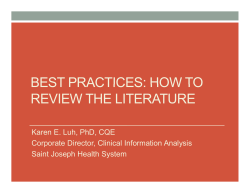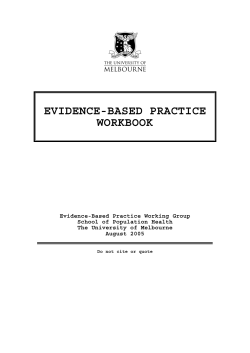
Document 236296
Evidence Based Practice or Practice Based Evidence: what is the difference ? Dr Anne Payne Associate Professor of Dietetics Overview 1. 2. 3. 4. 5. What is Evidence Based Practice (EBP)? What is Practice Based Evidence .. a practitioners view? Current view and critique of the EBP model. What next…..how do we change practice? Conclusions Evidence-based Practice (EBP) What is it? “............the conscientious, explicit and judicious use of current best evidence in making decisions about the care of individual patients” (Sackett et al 1996) EBP – Why do we need EBP? • EBP helps patients and practitoner’s to make informed decisions about health-care and so promotes better quality care. • EBP helps healthcare providers to understand the effectiveness, and comparative effectiveness of different types of care to ensure best use of resources. EBP – Why? In essence we are asking……… ‘Is the right person doing the right thing, at the right time, in the right place in the right way, with the right result ?’ Evidence Triad – Fundamental Principles of EBP Adapted from: Sackett DL, Rosenberg MC, Gray JA, Haynes RB, Richardson WS. Evidence based medicine: what it is and what it isn't. BMJ. 1996;312: 71-72. Evidence Based Practice…. • Integrates best available external clinical evidence from systematic research ……with • Practice Based Evidence/ Individual clinical expertise …..while • Taking into account patient preferences/values The 5 stages of EBP 1. Formulate a clinical question: eg use of the PICO format (Population Intervention Comparison Outcome) 2. Search for relevant evidence: define a research strategy and key words 3. Critical appraisal /Evaluation of the evidence for validity and usefulness to identify best practice 4. Implement change: your Action Plan 1. Audit the impact of change Hierarchies of Evidence 1. Systematic reviews (including meta-analyses) 2. Randomised Controlled Trials & other experimental research 3. Non-experimental research e.g. surveys, qualitative research 4. Conference & seminar reports, examples of good practice 5. Expert opinion The research evidence: key tools •Systematic reviews & meta analysis: – eg. The Cochrane Collaboration •Clinical guidelines – eg. SIGN and NICE Patient Clinical Records Research & Systematic review Audit & Evaluation of change Patient preference & needs EBP informed clinical decision making Ethical Principles & Professional Codes Practice Based Evidence: clinical judgement & expertise Clinical Guidelines (in UK NICE/SIGN) Care Pathways NSFs Practice Based Evidence: the practitioners expertise… Defined by Sackett et al as: ‘the ability to use our clinical skills & past experience to rapidly identify each patient’s unique health state & diagnosis, their individual risks & benefits of potential interventions, & their personal values & expectations.’ Practice Based Evidence Practice Based Evidence can take many forms: •personal experience and theoretical knowledge •reflective practice (practitioner derived knowledge) •audit evaluation of practice and practice based research. Personal experience and knowledge For example: •University education •Diversity of clinical experience •Continuing Professional Development (CPD) Reflective practice Reflection on practice: •A powerful clinical tool to inform and enhance our clinical practice. It is a key tool in our undergraduate programmes •Gibbs reflective cycle is a popular model, as pictured. Reflection in practice Dynamic process: sound communication skills Immediate outcome Informs decision making process Requires experience and confidence Practice based research and audit • Clinical audit: the audit cycle is a key component of effective evidence based practice • Clinical research: The identification of appropriate clinical outcome measures /criteria is now recognised as essential to assess the effectiveness of clinical care, whether by audit or original research (BDA 2011) Critique of EBP Too focused on research evidence: Systematic Reviews and RCT’s Patient needs not adequately addressed (each is unique) Does not take adequate account of Clinical Expertise Should we use the term Evidence Informed Practice ‘EIP’ rather han EBP ?? (Nevo & Slonim-Nevo (2011) What next....how do we change practice? Having identified best practice how do we now change practice? What are the barriers to change? Are they personal or institutional and how can we overcome these? What Are are the key steps to implement change? dietitians being taught EBP in University or ‘on the job’ as CPD? Do we need to learn new skills? Personal barriers to change Time to read original research papers Time to do research and audit Knowledge of the EBP process Confidence in the interpretation of statistics Reference: Heiwe S et al (2011) Individual barriers…do you recognise this person……….. • Continues to work only with knowledge gained when qualified • Uses of out of date textbooks • Is not aware of new research • Works in isolation from interested colleagues • Does not see value of EBP to clinical practice • Feels threatened by change Institutional barriers to change…. • • • • Lack of authority to make changes to existing policy Lack of resources and budgets Lack of co-operation from others e.g. the Multi-disciplinary Team Lack of time to implement the change & train staff How do we overcome barriers? Team leader with sound knowledge of relevant evidence base Academic support Multidisciplinary working groups Developing research culture. Training in management and leadership to implement change Managerial support Dedicated time out for study Helpful levers for change......... The ‘Expert Patient’ can prompt the most resistant practitioner to update their practice Opinion leaders and clinical champions can raise awareness of the need for change in practice Public opinion can influence health policy EBP requires organisational commitment Key Steps to Implementing Change Analyse the change required to identify a strategy…… 1. Identify the key elements of change….. ◦ Do you plan to introduce a new assessment tool ◦ A new care-pathway ◦ A novel nutritional supplement? Identify the economic, material and staffing resources required to implement change. 2. 3. Identify key stakeholders……….. Key Stakeholders? Fellow professionals e.g. MDT Boss/Line Manager Health service management Director of research Policy makers Patients Media Research funders Key Steps to Implementing Change 1. Assess whether key stakeholders & individuals are prepared for change Identification of potential barriers to change Identification of enabling factors e.g. clinical champions 2. Set an time-limited Action Plan for change 3. Evalute the impact of change via the audit cycle Do dietitian’s need to learn new skills? The key skills to be an effective practitioner of EBP are: oComprehension of the EBP process oKnowledge of audit and research methodology, including the interpretation of statistics oUse of reflection in clinical practice oWell developed client communication skills to ensure that the patients view is heard. oWell developed team communication skills and presentation skills to implement change…… Conclusion Evidence Based Practice and Practice Based Evidence: what is the difference?? In my view the majority of our clinical practitioners are working to implement ‘Best Practice’ via PBE and so are already engaged in the ‘EBP’ process, even if they are not fully aware of it. They need to recognise their skills, abilities and achievements and strive to build a strong EBP culture in their workplace. New tools are being developed to help us do it even better and this is the subject of this afternoons presentations on the PEN tool. References British Dietetic Association (2011) Model for Dietetic Outcomes. Birmingham, UK. Craig JV and Symth RL (2007) The Evidence-Based Practice Manual for Nurses (2nd edition); Churchill Livingstone, Elsevier, UK. Heiwe S et a (2011) Evidence Based Practice: attitudes, knowledge and behaviour among allied health care professionals. Int J for Quality in Health Care; 23(2): 198-209 Livingston EH and McNutt RA (2011) The hazards of evidence-based medicine – assessing variation in care. JAMA; 306 (7): 762-763. Nevo I and Slonim-Nevo E (2011) The myth of evidence-based practice: towards evidence informed practice. B J Social Work; 1-22. Palisano RJ (2011) Practice Knowledge: the forgotten aspect of EBP. Physical and Occupational Therapy in Pediatrics 30(4) 261-263 Payne A and Barker H (eds) (2010) Advancing Dietetics and Clinical Nutrition; Churchill Livingstone, Elsevier, UK. Sackett DL, Rosenberg MC, Gray JA, Haynes RB, Richardson WS (1996) Evidence based medicine: what it is and what it isn't. BMJ; 312: 71-72.
© Copyright 2025





















